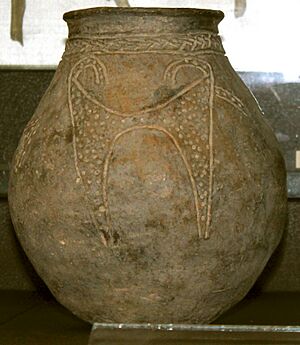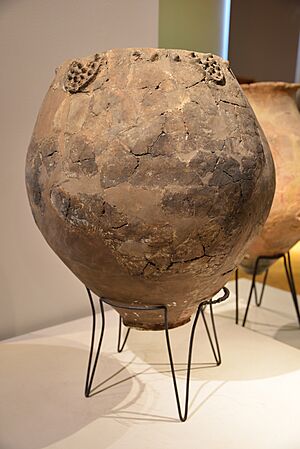Shulaveri–Shomu culture facts for kids
| Geographical range | southern Caucasus region |
|---|---|
| Period | Neolithic |
| Dates | c. 6000 BC – c. 5000 BC |
| Major sites | Shaumiani, Shomu-tepe |
| Preceded by | Trialetian culture |
| Followed by | Kura–Araxes culture, Trialeti culture |
The Shulaveri–Shomu culture was an ancient group of people. They lived in parts of what is now Georgia, Azerbaijan, Armenia, and northern Iran. This was during the late Neolithic (New Stone Age) and early Eneolithic (Copper Age). They lived from about 7000 BC to 5000 BC. This culture is also sometimes called the Shulaveri-Shomutepe-Aratashen culture.
Contents
Where Did They Live?
This culture is named after three important places. These are Shulaveri in Georgia, Shomu-Tepe in Azerbaijan, and Aratashen in Armenia. These sites helped experts learn about the culture.
Archaeologists found similar things at many sites. This showed that the same culture spread across the northern foothills of the Lesser Caucasus mountains.
Experts divide the Shulaveri-Shomu culture into three main groups. These groups are based on where they lived and what they made.
- The first group lived in the central South Caucasus. This includes parts of modern Azerbaijan and southeast Georgia. Important sites are Shomutepe, Shulavris Gora, Göytepe, and Mentesh Tepe.
- The second group lived in the Nakhichevan region and nearby plains. Sites include Kültepe I and Alikemek Tepesi. This group had links to northern Mesopotamia and Iran. They also knew how to work with metals.
- The third group lived in the Ararat Plain in Armenia. Sites here include Aratashen and Aknashen-Khatunarkh.
When Did This Culture Exist?
The Shulaveri–Shomu culture was active from about 7000 BC to 5000 BC. Most of their activity happened in the second half of the 6th millennium BC.
At first, experts thought this culture belonged to the Eneolithic (Copper Age). Now, they mostly see it as a Neolithic (New Stone Age) culture. However, some metal objects were found in the top layers of sites like Khramis Didi-Gora. This shows that metal use started later.
The Shulaveri–Shomu culture came before other important cultures in the area. These include the Maykop and Kura-Araxes cultures. They also came before the Trialeti culture from the Middle Bronze Age.
How They Lived: Daily Life
Farming and Food
The people of the Shulaveri-Shomu culture were skilled farmers. They knew a lot about raising animals and growing plants. They grew many types of cereals, like 10 kinds of wheat and several types of barley. They also grew oats, millet, lentils, peas, and beans. They even grew grapes, melons, and other plants. This suggests they had been farming for a long time.
They raised animals like goats, sheep, cows, pigs, and dogs. These animals were important from the very beginning of the culture.
Farmers sometimes used irrigation canals to help their crops grow. Around 5900 BC, people at Gadachrili tried to move water from the Shulaveri river to their fields. This is the oldest example of water management in the Caucasus.
Hunting and fishing were not as important for food. They hunted animals like deer, wild goats, wild horses, and hares. They also caught fish like gobio and sturgeon.
Homes and Villages
Shulaveri-Shomu villages were often built on small hills. These hills grew over time as people lived in the same spot for many years. Villages usually had three to five small settlements. Most were less than 1 hectare in size. They likely had dozens or hundreds of people. Some larger sites, like Khramis Didi Gora, were much bigger. They could be 4 or 5 hectares and have thousands of residents.
Some larger villages might have been central places for groups of smaller villages. Some settlements had trenches around them. These might have been for defense or for special ceremonies.
Their homes were round, oval, or semi-oval. They were made of mud-bricks and had domed roofs. Each building usually had one room and one floor. They had fireplaces inside. Larger buildings (2 to 5 meters wide) were for living. Smaller ones (1 to 2 meters wide) were for storage. Homes had narrow doorways. Floors might have been painted red. Holes in the roof let in light and air.
Small, round clay bins were common in their homes. These were partly underground. They were likely used to store grain or tools.
What They Made: Tools and Pottery
The Shulaveri-Shomu people made pottery by hand. Early on, they had very few ceramic pots. These were brought in from other places. Local pottery making started around 5800 BC. They used local clay and decorated their pots with patterns.
Here's how their pottery changed over time:
| I stage | Rough pots with a base that stuck out |
| II stage | Nicely decorated pottery |
| III stage | Rough, colored, and decorated pots with flat bases |
| IV stage | Dyed pots |
| V stage | Fine, red, shiny pottery |

They made tools from materials like obsidian (a type of volcanic glass), bone, and antler. These tools included blades, burins (for engraving), and scrapers. Pestles, used for grinding, were mostly made of basalt rock.
Early Metal Use
Metal objects are rare at Shulaveri-Shomu sites. But they become more common towards the end of the culture, around 5000 BC. These early metal items were often made of pure copper. They were used for small tools or decorations.
In Armenia, 57 copper beads were found at the Aratashen site. In Azerbaijan, signs of metalwork were found at Göy-Tepe. However, metalworking became much more common later, with the Sioni culture.
Beliefs and Burials
They didn't bury many people. When they did, bodies were usually found under house floors or in courtyards. At one site, Mentesh Tepe, a tomb held the skeletons of 31 people of different ages.
Archaeologists found small human-like figures, mostly of seated women. These figures might have been used in religious ceremonies. They could have been part of a fertility cult, hoping for good crops and many children.
The First Winemakers
The oldest proof of domesticated grapes comes from the Shulaveri area in Georgia. At a site called Gadachrili gora, scientists found evidence dating back to about 6000 BC. This shows that people were growing grapes there very early on.
Scientists also found chemicals from wine in large pottery jars at Shulaveri-Shomu sites. These jars were likely used to make, store, and serve wine. This evidence, from around 6000 BC, is the earliest sign of winemaking and grape growing in the Near East.
Connections to Other Cultures
Many features of the Shulaveri-Shomu culture are similar to those of other ancient cultures. These include their round mud-brick buildings and pottery with special designs. Their human-like figures and obsidian tools are also similar. These traits might have come from older cultures in the Near East, like the Hassuna and Halaf cultures.
Their bone tools are also like those from the Middle East Neolithic period. Even their grinding stones and the use of red ochre are similar to the Halaf culture. These connections show that ancient people shared ideas and technologies across different regions.
See also
- Trialeti culture
- Archaeology of Azerbaijan
- Prehistoric Armenia
- Prehistoric Georgia
- Kura-Araxes culture
- Goytepe archaeological complex




